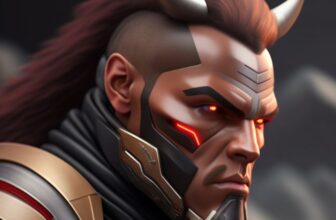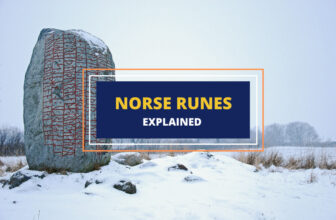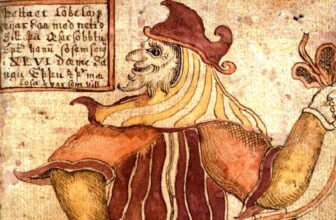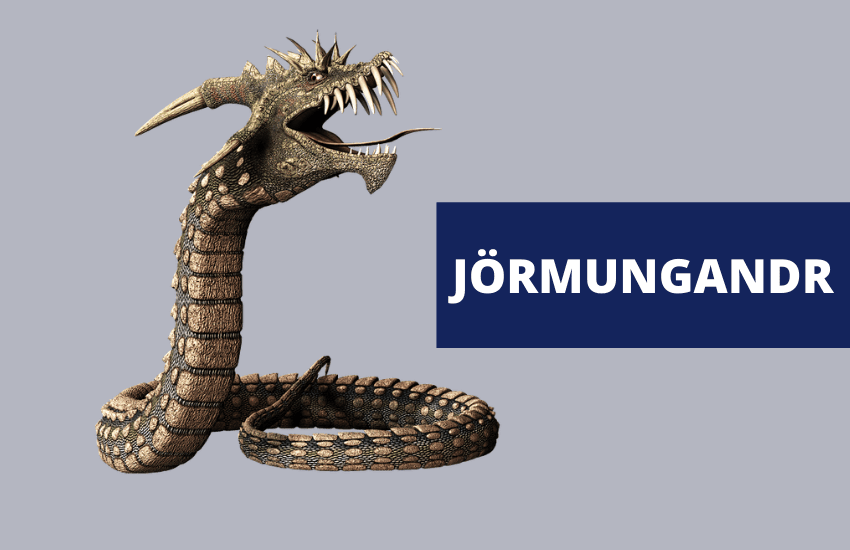
Table of Contents
There are many monsters in Nordic folklore and mythology but none inspire as much terror as the World Serpent Jörmungandr. Even the World Tree dragon Níðhöggr, who constantly gnaws at the tree’s roots, isn’t as feared as the giant sea serpent.
With its name roughly translating to “Great Beast”, Jörmungandr is the Nordic serpent/dragon fated to signal the end of the world and to kill the thunder god, Thor during Ragnarok, the battle at the end of the world.
Who is Jörmungandr?
Despite being a giant serpent-like dragon that encompasses the whole world with its length, Jörmungandr is actually a son of the trickster god Loki. Jörmungandr is one of three children of Loki and the giantess Angrboða. His two other siblings are the giant wolf Fenrir, destined to kill the All-Father god Odin during Ragnarok and the giantess/goddess Hel, who rules the Nordic Underworld. It’s safe to say that Loki’s children aren’t every parent’s dream.
Of the three of them, however, Jörmungandr’s forewarned destiny was definitey the most significant – the giant serpent was prophesied to grow so large that he’d encompass the whole world and bite his own tail. Once Jörmungandr released his tail, however, that’d be the beginning of Ragnarok – the Nordic mythological cataclysmic “End of days” event.
In this regards, Jörmungandr is similar to the Ouroboros, also a serpent who eats his own tail and is layered with symbolic meaning.
Ironically, when Jörmungandr was born, Odin tossed the then-still-small serpent into the sea out of fear. And it was exactly in the sea that Jörmungandr grew undisturbed until it earned the moniker World Serpent and fulfilled his destiny.
Jörmungandr, Thor, and Ragnarok
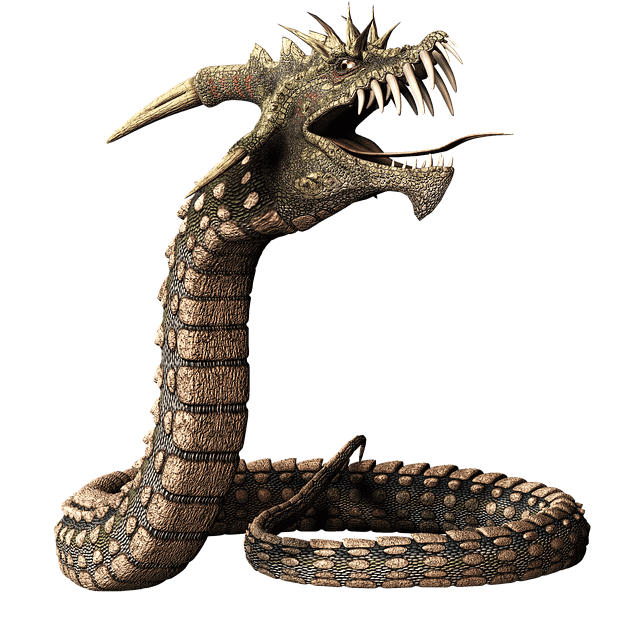
There are several key myths about Jörmungandr in Nordic folklore, best described in the Prose Edda and Poetic Edda. According to the most popular and widely-accepted myths, there are three key meetings between Jörmungandr and the thunder god Thor.
Jörmungandr dressed as a cat
The first meeting between Thor and Jörmungandr was because of the trickery of the giant king Útgarða-Loki. According to the legend, Útgarða-Loki issued a challenge to Thor in an attempt to test his strength.
To pass the challenge Thor had to lift a giant cat above his head. Little did Thor know that Útgarða-Loki had disguised Jörmungandr as a cat through magic.
Thor pushed himself as far as he could and managed to lift one of the “cat’s” paws off the ground but couldn’t lift the entire cat. Útgarða-Loki then told Thor that he shouldn’t be embarrassed as the cat was actually Jörmungandr. In fact, even lifting just one of the “paws” was a testament of Thor’s strength and had the god of thunder managed to lift the entire cat he would have altered the very boundaries of the Universe.
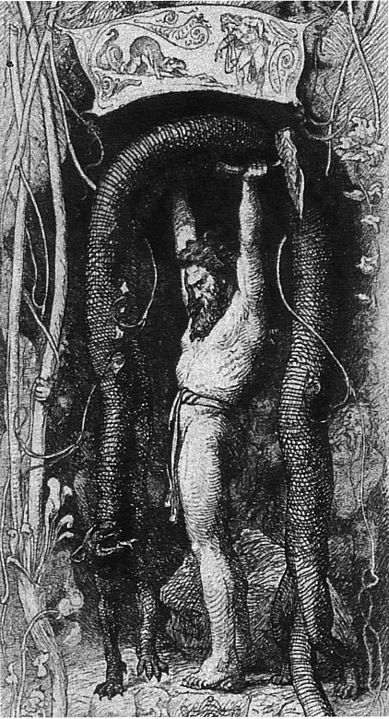
While this myth doesn’t seem to have an overly significant meaning, it serves to foreshadow Thor’s and Jörmungandr’s inevitable clash during Ragnarok and to showcase both the thunder god’s impressive strength and the serpent’s giant size. It’s also implied that Jörmungandr hadn’t yet grew to his full size as he hadn’t bitten his own tail at that time.
Thor’s fishing trip
The second meeting between Thor and Jörmungandr was much more significant. It happened during a fishing trip Thor had with the giant Hymir. As Hymir had refused to provide Thor with bait, the god of thunder had to cut off the head of the largest ox in the land to use it as bait.
Once the two started fishing Thor decided to sail further into the sea despite Hymir’s protests. After Thor hooked and tossed the ox’s head into the sea, Jörmungandr took the bait. Thor managed to pull the serpent’s head from the water with blood and poison spewing from the monster’s mouth (implying that he hadn’t yet grown large enough to bite his own tail). Thor lifted his hammer to strike and kill the monster but Hymir grew scared that Thor would initiate Ragnarok and cut the line, freeing the giant serpent.
In older Scandinavian folklore, this meeting actually ends with Thor slaying Jörmungandr. However, once the Ragnarok myth became “official” and widespread across most Nordic and Germanic lands, the legend change to Hymir freeing the serpentine dragon.
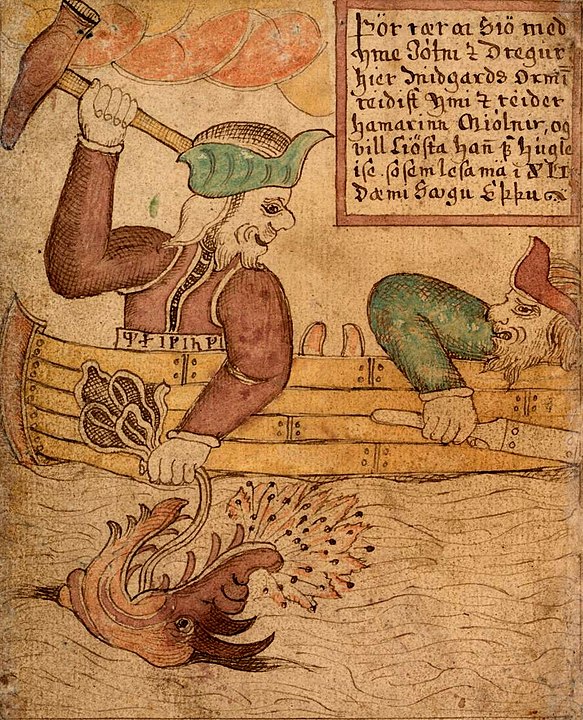
The symbolism of this meeting is clear – in his attempt to prevent Ragnarok, Hymir actually ensured it. Had Thor managed to slay the serpent then and there, Jörmungandr wouldn’t have been able to grow larger and encompass the entire Midgard “Earth-realm”. This reinforces the Norse belief that destiny is inevitable.
Ragnarok
The last meeting between Thor and Jörmungandr is the most famous one. After the serpentine sea dragon initiated Ragnarok, Thor engaged him in battle. The two fought for a long time, essentially preventing Thor from helping his fellow Asgardian deities in the war. Thor managed to eventually kill the World Serpent but Jörmungandr had poisoned him with his venom and Thor died soon after.
The Symbolic Meaning of Jörmungandr as a Norse Symbol
Like his brother Fenrir, Jörmungandr is also a symbol of predestination. The Norse people were firm believers that the future is set and couldn’t be changed – all everybody could do was just play their part as nobly as they could.
However, while Fenrir is also a symbol of retribution, as he takes his revenge on Odin for chaining him in Asgard, Jörmungandr isn’t associated with such “righteous” symbolism. Instead, Jörmungandr is viewed as the ultimate symbol of fate’s inevitability.
Jörmungandr is also viewed as the Nordic variant of the Ouroboros serpent. Originating from East African and Egyptian myths, Ouroboros is also a giant World Serpent that encircled the world and bit his own tail. And, like Jörmungandr, Ouroboros symbolizes the world’s ending and rebirth. Such World Serpent myths can also be seen in other cultures, although it’s always unclear whether they are connected or were created separately.
To this day many people wear jewelry or tattoos with Jörmungandr or Ourobors twisted in a circle or the infinity symbol.
Wrapping Up
Jörmungandr is a pivotal figure in Norse mythology, and remains an awe-inspiring, frightening figure. He signifies the inevitability of destiny and the one that brings about the battle that ends the world.




